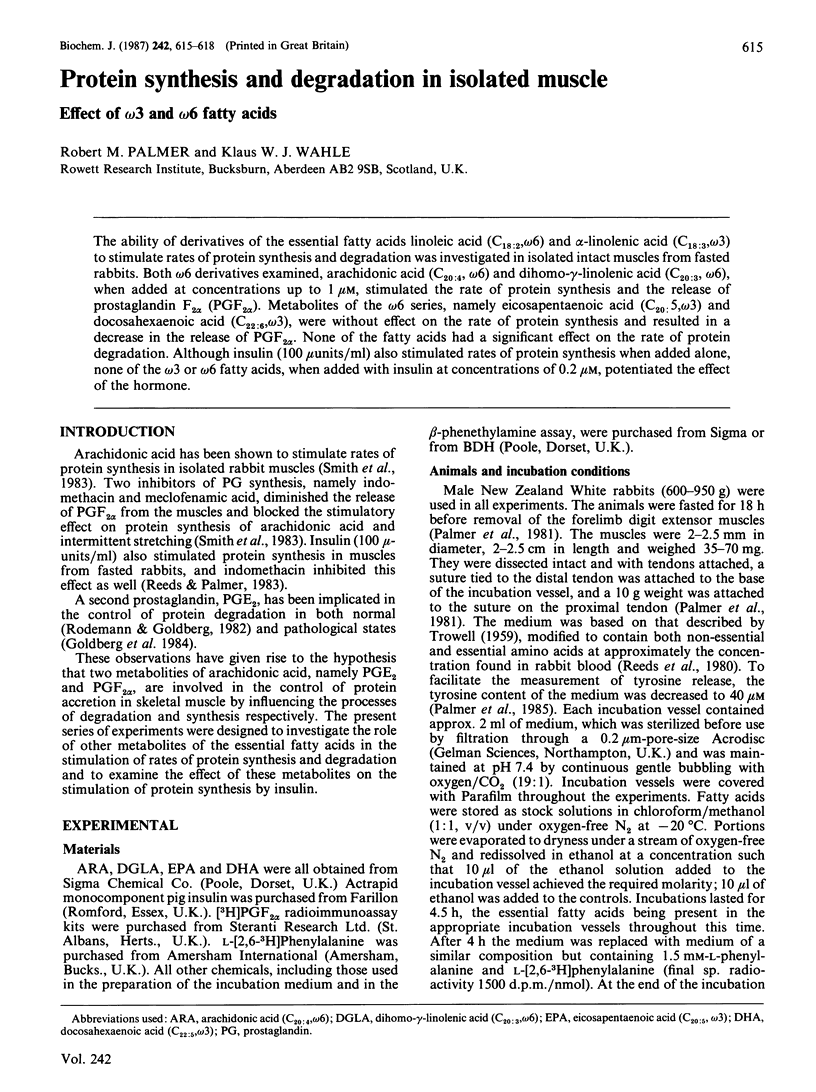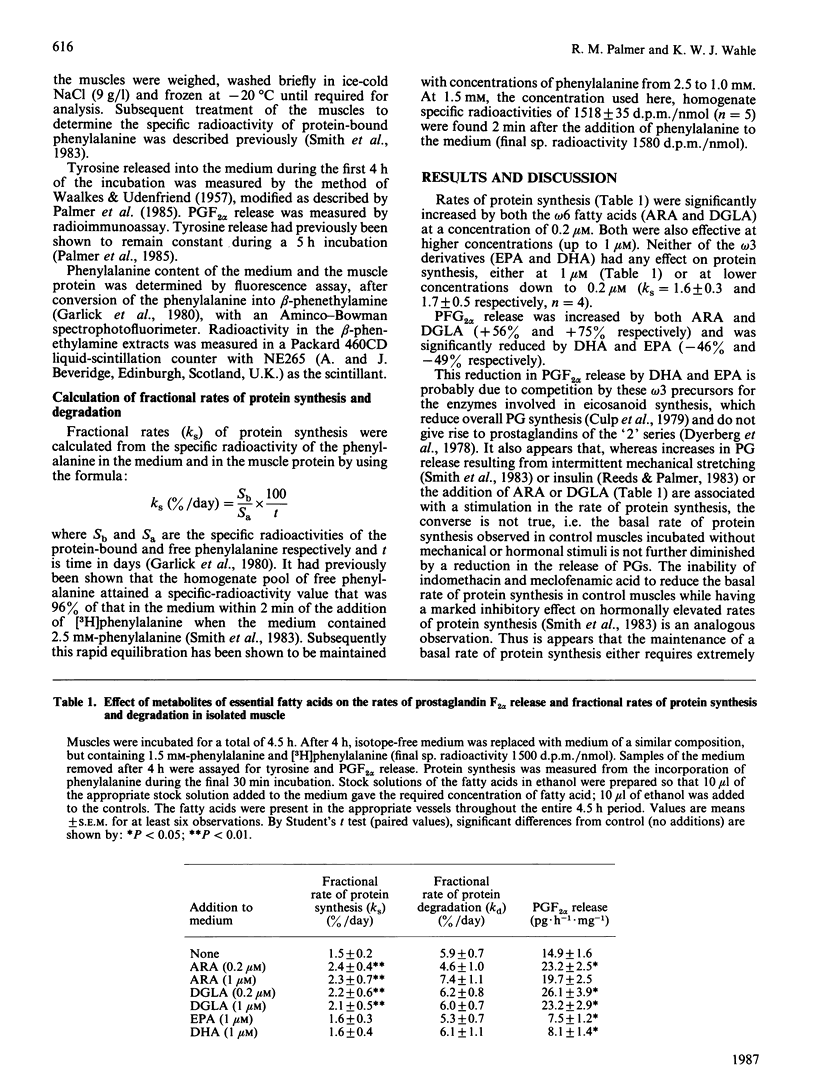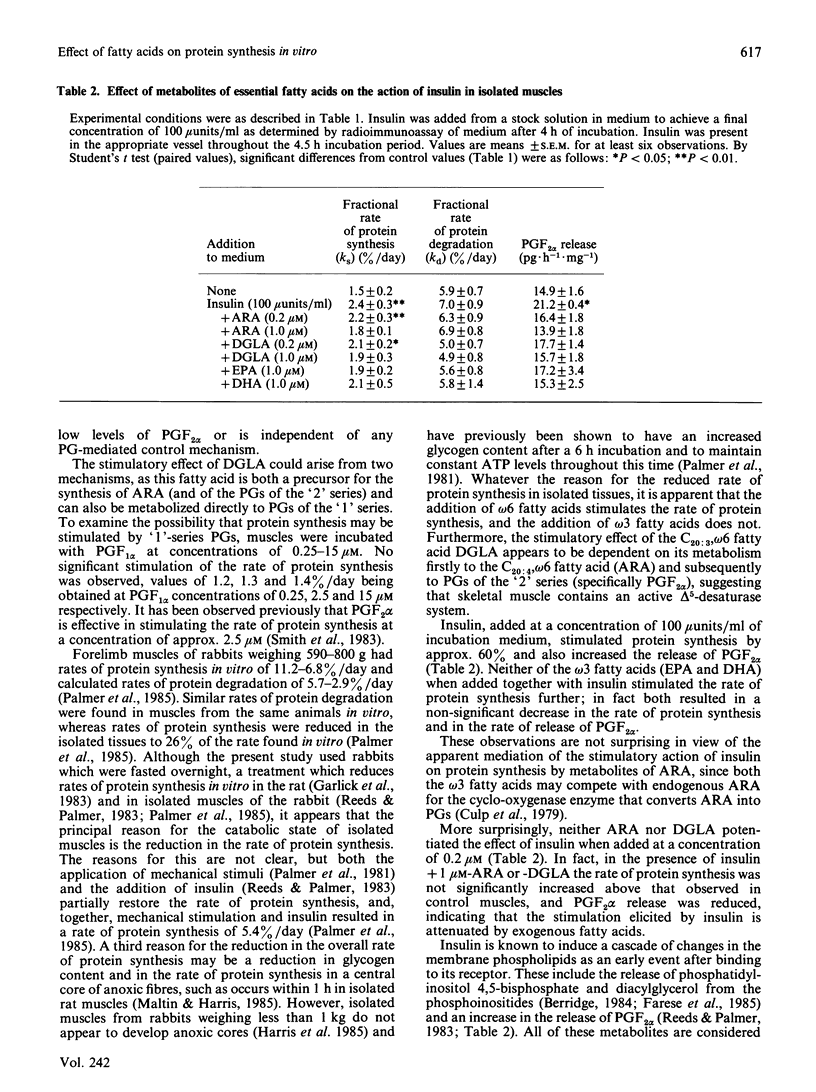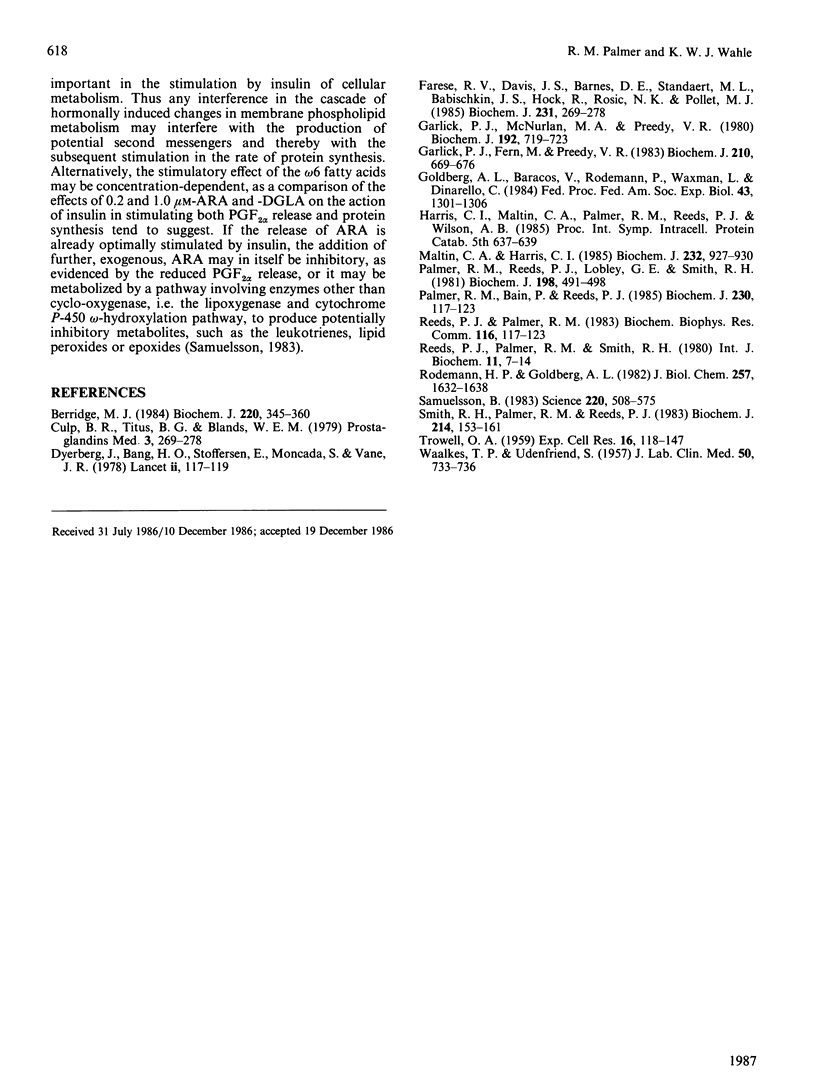Abstract
The ability of derivatives of the essential fatty acids linoleic acid (C18:2, omega 6) and alpha-linolenic acid (C18:3, omega 3) to stimulate rates of protein synthesis and degradation was investigated in isolated intact muscles from fasted rabbits. Both omega 6 derivatives examined, arachidonic acid (C20:4, omega 6) and dihomo-gamma-linolenic acid (C20:3, omega 6), when added at concentrations up to 1 microM, stimulated the rate of protein synthesis and the release of prostaglandin F2 alpha (PGF2 alpha). Metabolites of the omega 6 series, namely eicosapentaenoic acid (C20:5, omega 3) and docosahexaenoic acid (C22:6, omega 3), were without effect on the rate of protein synthesis and resulted in a decrease in the release of PGF2 alpha. None of the fatty acids had a significant effect on the rate of protein degradation. Although insulin (100 mu units/ml) also stimulated rates of protein synthesis when added alone, none of the omega 3 or omega 6 fatty acids, when added with insulin at concentrations of 0.2 microM, potentiated the effect of the hormone.
Full text
PDF



Selected References
These references are in PubMed. This may not be the complete list of references from this article.
- Berridge M. J. Inositol trisphosphate and diacylglycerol as second messengers. Biochem J. 1984 Jun 1;220(2):345–360. doi: 10.1042/bj2200345. [DOI] [PMC free article] [PubMed] [Google Scholar]
- Culp B. R., Titus B. G., Lands W. E. Inhibition of prostaglandin biosynthesis by eicosapentaenoic acid. Prostaglandins Med. 1979 Nov;3(5):269–278. doi: 10.1016/0161-4630(79)90068-5. [DOI] [PubMed] [Google Scholar]
- Dyerberg J., Bang H. O., Stoffersen E., Moncada S., Vane J. R. Eicosapentaenoic acid and prevention of thrombosis and atherosclerosis? Lancet. 1978 Jul 15;2(8081):117–119. doi: 10.1016/s0140-6736(78)91505-2. [DOI] [PubMed] [Google Scholar]
- Farese R. V., Davis J. S., Barnes D. E., Standaert M. L., Babischkin J. S., Hock R., Rosic N. K., Pollet R. J. The de novo phospholipid effect of insulin is associated with increases in diacylglycerol, but not inositol phosphates or cytosolic Ca2+. Biochem J. 1985 Oct 15;231(2):269–278. doi: 10.1042/bj2310269. [DOI] [PMC free article] [PubMed] [Google Scholar]
- Garlick P. J., Fern M., Preedy V. R. The effect of insulin infusion and food intake on muscle protein synthesis in postabsorptive rats. Biochem J. 1983 Mar 15;210(3):669–676. doi: 10.1042/bj2100669. [DOI] [PMC free article] [PubMed] [Google Scholar]
- Garlick P. J., McNurlan M. A., Preedy V. R. A rapid and convenient technique for measuring the rate of protein synthesis in tissues by injection of [3H]phenylalanine. Biochem J. 1980 Nov 15;192(2):719–723. doi: 10.1042/bj1920719. [DOI] [PMC free article] [PubMed] [Google Scholar]
- Goldberg A. L., Baracos V., Rodemann P., Waxman L., Dinarello C. Control of protein degradation in muscle by prostaglandins, Ca2+, and leukocytic pyrogen (interleukin 1). Fed Proc. 1984 Apr;43(5):1301–1306. [PubMed] [Google Scholar]
- Harris C. I., Maltin C. A., Palmer R. M., Reeds P. J., Wilson A. B. Biochemical and morphological observations of skeletal muscles incubated in vitro. Prog Clin Biol Res. 1985;180:637–639. [PubMed] [Google Scholar]
- Maltin C. A., Harris C. I. Morphological observations and rates of protein synthesis in rat muscles incubated in vitro. Biochem J. 1985 Dec 15;232(3):927–930. doi: 10.1042/bj2320927. [DOI] [PMC free article] [PubMed] [Google Scholar]
- Palmer R. M., Bain P. A., Reeds P. J. The effect of insulin and intermittent mechanical stretching on rates of protein synthesis and degradation in isolated rabbit muscle. Biochem J. 1985 Aug 15;230(1):117–123. doi: 10.1042/bj2300117. [DOI] [PMC free article] [PubMed] [Google Scholar]
- Palmer R. M., Reeds P. J., Lobley G. E., Smith R. H. The effect of intermittent changes in tension on protein and collagen synthesis in isolated rabbit muscles. Biochem J. 1981 Sep 15;198(3):491–498. doi: 10.1042/bj1980491. [DOI] [PMC free article] [PubMed] [Google Scholar]
- Reeds P. J., Palmer R. M., Smith R. H. Protein and collagen synthesis in rat diaphragm muscle incubated in vitro: the effect of alterations in tension produced by electrical or mechanical means. Int J Biochem. 1980;11(1):7–14. doi: 10.1016/0020-711x(80)90274-8. [DOI] [PubMed] [Google Scholar]
- Rodemann H. P., Goldberg A. L. Arachidonic acid, prostaglandin E2 and F2 alpha influence rates of protein turnover in skeletal and cardiac muscle. J Biol Chem. 1982 Feb 25;257(4):1632–1638. [PubMed] [Google Scholar]
- Samuelsson B. Leukotrienes: mediators of immediate hypersensitivity reactions and inflammation. Science. 1983 May 6;220(4597):568–575. doi: 10.1126/science.6301011. [DOI] [PubMed] [Google Scholar]
- Smith R. H., Palmer R. M., Reeds P. J. Protein synthesis in isolated rabbit forelimb muscles. The possible role of metabolites of arachidonic acid in the response to intermittent stretching. Biochem J. 1983 Jul 15;214(1):153–161. doi: 10.1042/bj2140153. [DOI] [PMC free article] [PubMed] [Google Scholar]
- TROWELL O. A. The culture of mature organs in a synthetic medium. Exp Cell Res. 1959 Jan;16(1):118–147. doi: 10.1016/0014-4827(59)90201-0. [DOI] [PubMed] [Google Scholar]
- WAALKES T. P., UDENFRIEND S. A fluorometric method for the estimation of tyrosine in plasma and tissues. J Lab Clin Med. 1957 Nov;50(5):733–736. [PubMed] [Google Scholar]


